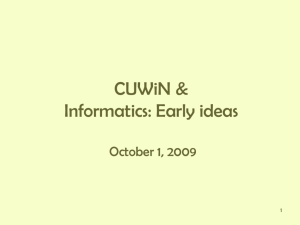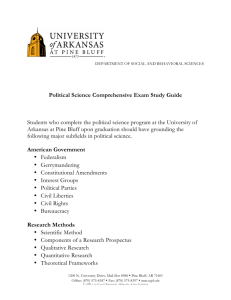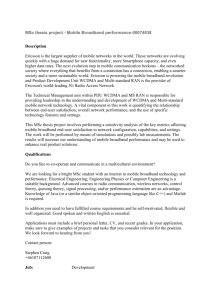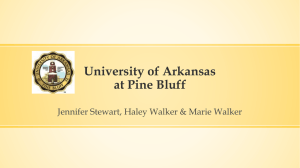class 7 590COL Community perspectives and information age key
advertisement
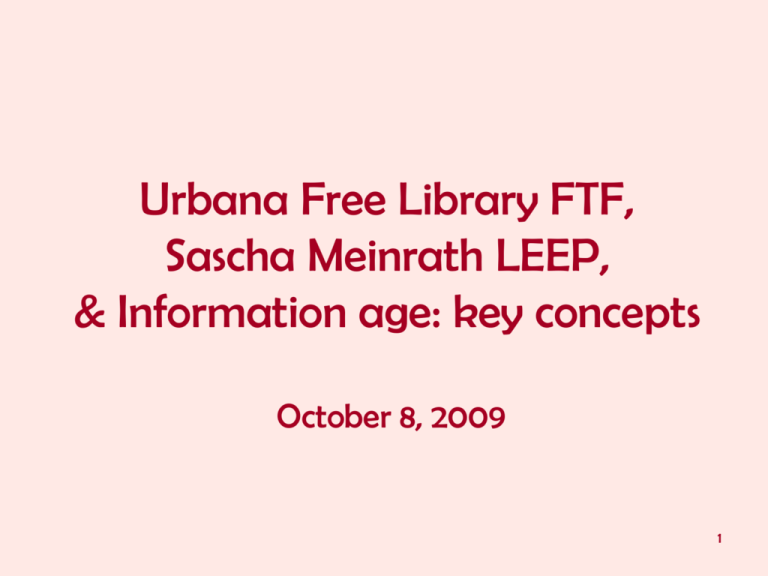
Urbana Free Library FTF, Sascha Meinrath LEEP, & Information age: key concepts October 8, 2009 1 1. What is Community Informatics • CI: the study or practice regarding the continuity of local, historical communities meeting the transformation of information technologies • Libraries by reinventing themselves (I&R, job centers, OPACs) invented community networks (made of siliconplus-carbon) • From social informatics comes three key ideas: network society, hacker ethic, and digital inequality …the LOCAL community is the central focus here 2 2. Community: ‘Race’, place and history 1. Science says, One race, the human race. Our species has always migrated, our differences are within group not between group. No one trait is found across a group. 2. Racism is real … What to do? Stay educated (on past, present, future) … Practice diversity in curriculum, profession, library 3. Class: an emergent phenomenon, as well as a categorical or positional reality, thanks to techno-economic changes 4. Root Shock: Severing people’s connections to places. “The traumatic stress reaction to destruction of one’s emotional ecosystem.” Mass upheavals have ripple effect. Solution: Acknowledge. Create healing places. Displacement the 21st C problem. 3 5. ‘Damned by ourselves, saved by community.’ 3. Dig Div, Community as network 1. Dig Div: a fxn of the information revolution. Persistent, multidimensional & changing. CI solutions mean a) communities not individuals b) seeking sustainability 2. Society ≠ Individuals … Society = Ties ! 3. Wellman/Leighton: Urbanization brings… • Community found/strong nhood networks? • Community lost/no networks? • Community liberated/metropolitan networks? • [Q: where do space and time go in SN theory?] 4. Coleman: Closed networks build social capital • So do open networks! e.g. Murchison Center 4 3a. Network models groups as nodes strong & weak ties… 5 dense and sparse networks 4. UC2B: more on Above Ground • • UC2B: 36 million in stimulus/other funds. 2 cities + univ. Fiber laid across cities, 100 Mbps to 137 critical anchor institutions, 5 Mbps to 2500+ homes in 12 lowbroadband census tracts. Above ground, support for broadband adoption. UC2B Above Ground, 3+ years, guided by GSLIS: 1. 45 + 1 public computing centers boosted or established 2. Mad Lab in N Champaign (Music Access Digitization), HQ for community helpdesk, 14 outreach/support staff 3. 17 cybernavigators serving 46 ctrs + 12 sectors serving low income people (health, ed, libs, homeless, seniors, women, disabled, safety, churches, comm ctrs, media/culture) 4. Three course sequence for 50 UI/Parkland/high school students, public video • • • 5. 6. 7. 8. • Broadband 101 spring: what’s it all about Broadband 102 summer: paid broadband internships Broadband 103 fall: community-serving bband entrepreneurship, $50K in awards UC2B’s community helpdesk Community advisory committee, research advisory committee, PCCNet Community first, technology second (CI approach) Electrician training and business planning for people from underserved areas 6 Similarly nationwide 2010-2012; nat’l bband plan by Feb 2010; broadband.gov Link to entire UC2B application on City of Champaign site: http://tinyurl.com/completeUC2B 4a. Community and disaster: recap to come 7 5. Search for bband data, and virtual community • A campaign: campus mobilized, reached out to gov, comm 40 volunteers Navigating the complexities of the grant competition Found higher rate of broadband take-up 12 block groups eligible community ? government campus / corporations (telecoms) • From the bbs: The curse of grants and the challenge of inequality and difference • WELL: report from the info rev: virtual comm is possible, personal, gotta feel it – Virtual community as family & friend support network stands on and builds FTF • Wikipedia: social norms and technical design enable virtual community growth from 200 to 200,000 people … to … build an encyclopedia!?! – A culture e.g. simple rules for people like “Be Bold,” “NPOV” “Nice to newbies” “sofixit” – A technology e.g. software features like talk page … history … translation – What should people know about Wikipedia? – What can we learn for real-world communities? [commons based peer production, crowdsourcing] 8 • PS: comm vs .com (Spaniards walk & WELLites share vs SN sites as corporations) 6. CUWin (not his actual topic) & Informatics: Early ideas • Public interest telecom fighting it out in D.C. with telecoms – BTOP highly contested. 1956 hushaphone, 1968 carterfone … 90%+ spectrum unused = artificial scarcity of broadband. $10/unit in LA, $1300/unit in greenup IL bec market/prices are secret. Ultimately CUWin could not afford internet connection. • Vannevar Bush: The Memex. Data trails. – “A record if it is to be useful to science, must be continuously extended, must be stored, and above all much be consulted.” • Rob Kling: Introducing computer in orgs is a SOCIAL process – Transformative and conflict-ridden, not formal process run by managers – A package (hardware/software/skills/users/beliefs), not a tool (hard+software) – Power a key variable, e.g. formal processes for challenging databases not fair • Bill Mitchell: City of Bits – We’ve had CIVITAS (communities of family/culture) and URBS (settled cities). Now bits erase the tyranny of distance. Will we overcome bondage of broadband? Who will own our urbs and civitas: .com? .org? Will .gov help? 9 Can we design a global village—civitas and urbs on a global scale? • Dissect the discouragement • Key concepts of the information age – Lévy 1997: cyberculture – Himanen 2001: hacker ethic – Ludlow 2007: metaverse Agenda • About next week – LEEP students on campus – 9-9:50 in 126 DD lecture: Don Owen, Urbana Schools – 10-12 move to 131, both CI classes together – 1-2:20 Phoebe Ayers “Wikipedia, Communities, Librarians” 10 – 2:30-4 LEEP students continue class What is your public life? Or does private and personal life swallow you? • Private sphere (work and education) 1. Hours on the job? 2. Coursework? • Personal sphere (self, family, friends) 3. What are your home responsibilities and pleasures? 4. What is your window on the world (reading, other)? • Public sphere (organizations, community, society) 5. What gatherings do you go to and how often? (church plus) 6. What do you write or speak about, what do you contribute? 11
